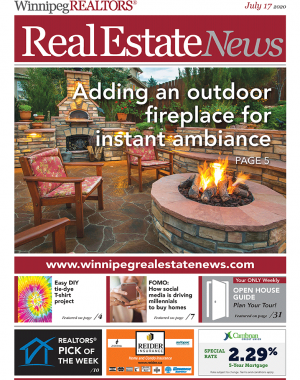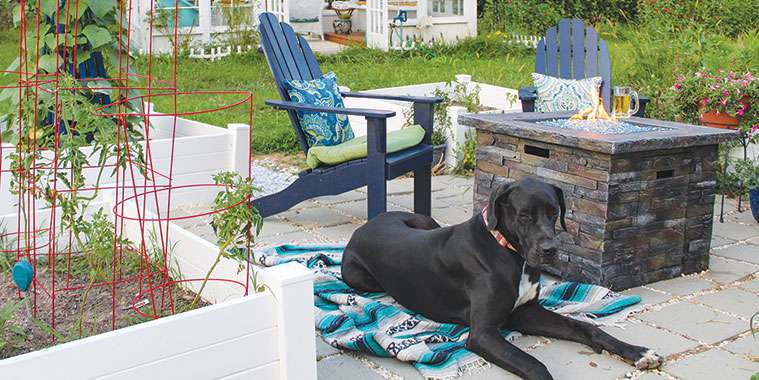Outdoor fireplaces are a backyard staple for many homeowners. Summer gatherings just wouldn’t feel the same without one.
Not only are they functional, providing a source of heat and light while allowing you to make the most out of your outdoor living space, but they can
also increase the appeal of your home while creating an atmosphere that reflects your individuality. Plus, who doesn’t want a spot in their own backyard to make s’mores whenever you want?
That said, installing an outdoor fireplace isn’t as straightforward as lighting a match. What type to choose, what fuel source to use, and where you place it are all questions requiring careful consideration.
Not to mention, local bylaws and codes must be strictly adhered to, which present challenges of their own. But a quick Google search of your area or even provincial regulations will let you know if there’s a burn ban in place or structural requirement you’ll need to meet before breaking out the kindling. When it comes to lighting a fire, some municipalities require a simple burn permit which can be registered with a phone call.
If everything’s a go, there’s no better time than now to ignite the outdoor space of your dreams. Read on to find which solution works best for you.
The three types of outdoor fireplaces
All fireplaces fall into three categories: wood-burning, gas-burning (natural gas, propane, or kerosene), or electric — and within those categories are four main types:
• Fire pits (rings, bowls, and built-in patio pits)
• Fireplaces
• Chimeneas
Just like selecting an indoor fireplace, it all comes down to function, features, and performance — each with its own application, advantages, and disadvantages. Explore the pros and cons of each type below:
1. Fire pits: rings, bowls, and patio pits
If you close your eyes and picture a fire pit, what pops into your head? It’s likely a traditional fire ring of rocks circling a shallow pit. Some modern pits can be quite lavish with mortared limestone surrounds, proper drainage systems, and even include fire glass.
Fire rings and their pits are permanent and would require some landscaping to relocate. Bowls, on the
other hand, come in different shapes, sizes, and materials and are placed on the ground or a stand for easy transportation and relocation anywhere in you yard.
Patio fire pits can be integrated into your patio, such as fire tables that give the outdoor dining experience a bit of ambiance, with the fire pit as the table’s centrepiece.
Fire rings are an easy DIY project. They’re inexpensive, easy to build and are a great project to complete over the weekend with the family. They can also be easy to move. Built-in patio fire pits are unrivalled when it comes to quality, aesthetics and customization.
However, fire bowls and rings fueled by wood produce wood smoke, a known pollutant, and with that comes safety concerns: fire rings have an open flame with uncontained sparks that present potential dangers. Also, costly renovations can be involved since built-in patio fire pits require pricey renovations and custom craftsmanship.
2. Fireplaces and heaters
Outdoor fireplaces can include various designs and features such as cottage-style chimneys, bronze inlaying and detailed stonework. If you want to give wood-burning a rest, gas-burning and electric-powered models are also available.
Outdoor fireplaces bring the heat with the sound and smell of burning wood. They are also less expensive than custom fire rings and built-in patio pits.
However, watch out for safety risks and pollutants; wood smoke from a fireplace creates pollution, while flames and sparks increase risk.
But if you choose to go with a fireplace fueled by natural gas or electricity, it will lack an authentic, wood-burning fire. Its also limited to outlet location and is less portable than those fueled by wood or propane.
3. Chimeneas
Chimeneas are centuries old and combine function with fashion. Decorative wood-burning chimeneas are shaped like a wide-bottom vase with integrated chimneys, and they’re historically made from fired clay.
A chimenea is conducive to lighting a fire as its shape funnels oxygen to feed the flames. You can also control the smoke because the built-in chimney stack directs smoke up and away from the chimenea and out of your eyes. They also offer you optimal heat output, generating a lot of warmth by burning wood.
However, chimeneas are freestanding and require a level surface to increase safety. They also require lots
of upkeep — the body of a chimenea is an enclosed bowl that fills with ash quickly, and the chimney needs routine cleaning if used often, and because they don’t offer drainage, can fill with rain.
Which fireplace to choose
The outdoor space you’re working with will help you decide which fireplace you can install. If you want to bring the heat to your deck or porch, gas-burning fireplace is a great go-to option. If it’s a semi-enclosed space, the limited heat-radius won’t be as noticeable.
If you want to crank up the heat in wide, open spaces, look to wood-burning fireplaces, pits and chimeneas. Give them plenty of room to breathe, however. These options should be kept 10- to 20-feet away from walls and combustibles, plants and trees. They’re not recommended for enclosed decks or gazebos.
How you fuel your outdoor fireplace also determines which type you choose. Those that need an electrical outlet or natural gas line are not easily moved, while propane-fueled and wood-burning options provide more flexibility.
Now that you’ve narrowed done your fireplace, why not add a little flavour to your outdoor space? Here’s what you need to know about choosing the perfect grill!
Fireplace safety, bylaws, and codes
Smokey Bear charged us with the responsibility of preventing forest fires and holds true for your outdoor fireplace, too.
Here are a few safety considerations to bear in mind:
• Don’t leave a burning fire unattended.
• Be prepared for an emergency. It’s wise to have a bucket of sand, a fire extinguisher or a garden hose nearby in case disaster strikes.
• Pay attention to the weather. High winds and periods of drought will turn sparks into fires (always check with your local fire department or municipality to see if there is a burn ban in place for this reason.)
• Choose hardwoods versus softwoods. Seasoned hardwood burns more consistently to limit sparks from popping unpredictably.
• Use tinder, not gasoline. Lighting a fire with gas is extremely dangerous and is always to be avoided.
• Keep it ventilated. Gas-burning fireplaces and heaters emit carbon monoxide, which is deadly in small, enclosed areas.
• Bigger isn’t better.The larger the fire, the less predictable it becomes making it harder to control.
Ultimately, your local bylaws and zoning codes have the final say in what type of outdoor fireplace you choose. Each province or territory has a different process, so be sure to check your local government’s website or your local fire department for regulations and recommendations.
For instance, firepits and wood-burning fireplaces are more acceptable in rural neighbourhoods, but if you live in the city, you’re likely limited to gas-burning models in covered bowls. If you live in a condo or townhouse, there’s a good chance outdoor fireplaces are prohibited altogether — check with your building management.
If the warm smell of wood smoke is something you crave or an elegant patio with a built-in fireplace is what you’re looking for in a new home, make sure you talk with your REALTOR® about the dos and dont’s in your new neighbourhood.
— Realtor.ca



